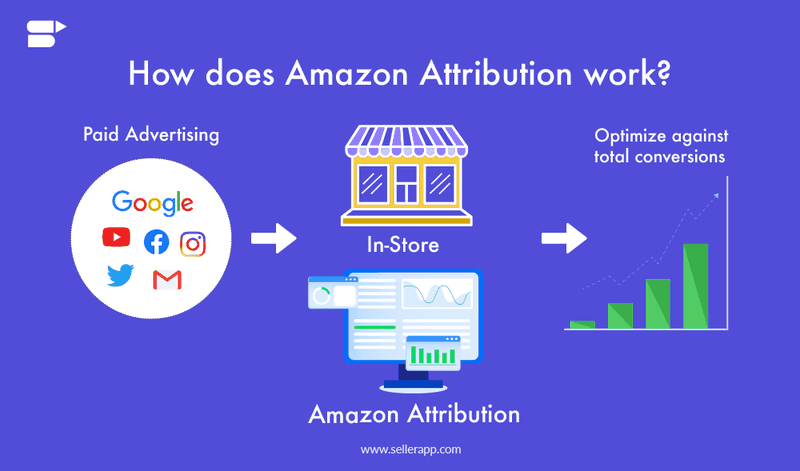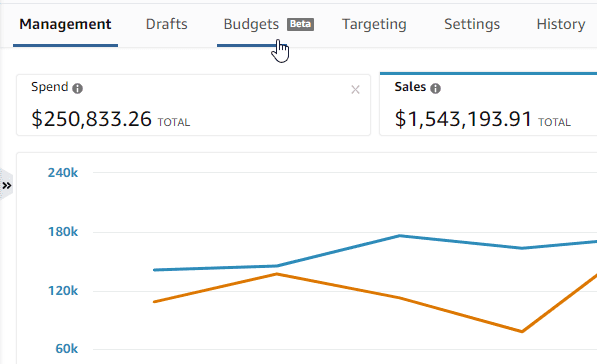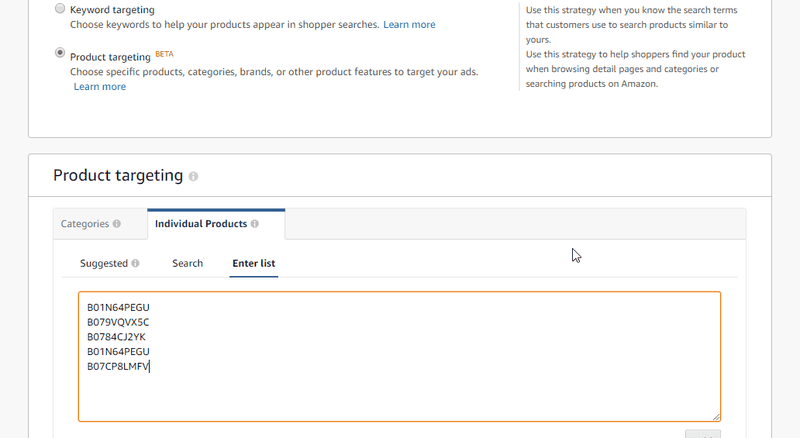What is Amazon Marketing Services (AMS) and How to Use It
Learn about what Amazon Marketing Services (AMS) is, what are the different ad types available on Amazon, and how to optimize your ROAS to the fullest.
Updated December 5, 2023.

Amazon Marketing Services (AMS) is a collective term for several services Amazon offers to its sellers. What's included in that umbrella are three ways to advertise your products on Amazon - Sponsored Products, Sponsored Brands, and Amazon Display Ads.
Amazon has over 300 million active customers worldwide and 75% of shoppers use Amazon to discover new products and brands. It's also a fast-growing platform among SMBs in a variety of industries. Studies show that over 50% of businesses spend $40,000 or more on Amazon ads every month.
When it comes to marketing products online, Amazon Marketing Services (AMS) has quickly become a go-to choice for many businesses as well as Amazon marketing agencies and experts. In fact, some marketers are moving 60% of their ad budgets from Google over to Amazon.
AMS offers a wide range of services that can help businesses better reach their target audience with highly effective ad campaigns. In this post, we'll take a look at what AMS is and how you can use it to your advantage.
What is Amazon Marketing Services (AMS)?
Amazon Marketing Services (AMS) is a collective name for all of Amazon's advertising products. It's actually been renamed to Amazon Advertising Console, but many marketers still refer to it as AMS. It's a set of Amazon ads tools that help sellers run and manage their ads and includes Sponsored Products Ads, Headline Search Ads (aka Amazon Sponsored Brands), and Amazon Display Ads.
AMS allows you to create, manage and optimize ad campaigns that appear in search results, product detail pages, and other areas across the Amazon platform. You can also tailor your campaign according to various criteria such as keywords, budget, geographical location, customer interests, product category, and more.
AMS also provides detailed reporting features that allow you to monitor performance metrics such as clicks and impressions so you can easily measure the success of each campaign and make adjustments accordingly. This information can be used to track customer behavior over time, identify high-performing keywords and optimize campaigns for maximum efficiency and return on investment.
Types of ads available through AMS
Amazon Marketing Services (AMS) offers various types of ads to help you reach and engage your target audience. Depending on your objectives, budget, and desired campaigns, you can select from different types of ads, such as Amazon Sponsored Products, display ads, and Amazon Sponsored Brands.
Let's look at each one.
Sponsored Display
Sponsored product ads (also known as Product Display Ads) are small, text-based advertisements on Amazon. They appear at the top of search results when customers enter specific keywords or on product pages, where you can choose different criteria for them, such as:
- The customer's interests
- Their search history
- Whether or not they're Prime members
Sponsored Display Ads can show images or videos, and they're most suitable for those who want to drive immediate sales or boost brand visibility with their target audience.
Requirements: Sponsored Display Ads are available to sellers in the Amazon Brand Registry, book vendors, vendors, as well as agencies with clients who sell products on Amazon.
Cost: Sponsored Display Ads work on a pay-per-click model, so you pay for each click you get on your ads (as opposed to paying for ad impressions.) The cost per click (CPC) for Sponsored Display Ads varies depending on the keyword’s competition level, the product category, and other factors. There's no minimum budget.
Sponsored Brand Ads
Sponsored Brand Ads (previously Headline Search Ads) are sponsored ads that appear at the top of search results when customers search for specific keywords. These ad units include a logo, a custom headline, and multiple products along with their pricing and high-level rating.
Sponsored Brand Ads help you spread product awareness when people are looking for something to buy.
Requirements: Amazon Sponsored Brand Ads are available for merchants enrolled in Amazon Brand Registry, as well as vendors, book vendors, and agencies.
Cost: Sponsored Brand Ads are available for a minimum daily budget of $1. Same as in the case of product ads, you will only pay for clicks. According to Amazon, brand ads have a 5.5x Return on Investment - so for every dollar you spend, you should get $5.5 back, with the right advertising strategy.
Video Ads
There are two types of Amazon video ads. The first type is regular video ads shown for products just as a normal product ad would, and there are also Amazon OTT video ads.
These are short clips shown in video streams, typically on connective TVs, in videos on Amazon Freevee, Twitch, TV channels and network broadcaster apps.
You can use these ads to target customers based on their search history and interests. They are designed to capture the customer’s attention with a simple yet effective message and help Amazon sellers to expand their reach and increase brand visibility.
Requirements: Anyone can advertise using Amazon's streaming ads, regardless of whether they sell a product. Brands, vendors, sellers, and agencies can all advertise with Amazon's streaming ads.
Cost: Amazon video ads are sold programmatically and you will pay on a cost-per-mille basis (i.e. you will pay for every 1,000 views your ads receive.) If you have a self-service package, you will need a $10k recommended campaign minimum. For a managed service package, you will need a $50k campaign minimum.
Amazon DSP
Amazon DSP (Demand Side Platform) is a platform that allows brands and advertisers to buy ads programmatically. It enables them to create customized ad campaigns tailored to their goals and target audience, with access to thousands of websites and mobile applications across the web.
DSP ads can be image-based, video, or audio, and they can be displayed on and off Amazon.
Requirements: Amazon DSP is available for vendors, sellers, agencies, or any other type of advertiser.
Cost: Pricing for DSP ads varies, according to format and placement. If you are a self-service customer, you are in full control of your campaigns and there are no management fees. However, if you're paying for the managed service option, you should prepare a $50k minimum spend (which may vary from one country to another.)
Amazon Attribution
Amazon Attribution is a powerful tool that enables brands and vendors to track the performance of their campaigns across different channels. It gives you an understanding of which campaigns are working, so you can measure your ROI and make smarter decisions about where to invest your budget.
Requirements: Amazon Attribution is available for vendors, sellers, agencies, or any other type of advertiser.
Cost: Unlike the other Amazon Marketing Services (such as the types of ads described above), Amazon Attribution is free.
Amazon stores
Amazon stores are the beating heart of the eCommerce giant. They're perfect way to showcase your products and create a personalized shopping experience for customers. With Amazon stores, you can add visuals, videos, editorial content, and product information to help visitors learn more about what you’re offering.
Requirements: Anyone with an Amazon account – vendors, sellers, or agencies – can set up an Amazon store.
Cost: Amazon stores are free to set up and use. However, there may be costs associated with hosting images or other media. Furthermore, there may be costs associated with using Amazon as an intermediary for your eCommerce activities.
Amazon’s suite of advertising options provides a comprehensive way for brands and sellers to reach their target audience on the platform. With multiple formats, targeting capabilities, and cost structures available, businesses can easily tailor their campaigns to fit any budget or goal.
Each type of AMS ad has its own set of advantages depending upon how it is used. However, taken together they provide powerful opportunities for businesses large and small looking to increase their presence on Amazon while driving sales growth across all channels.
How to optimize and manage Ads
Optimizing and managing ads through Amazon Marketing Services (AMS) is a key step in ensuring your ad campaigns are successful and getting the most out of your budget.
With AMS, there are several methods to optimize and manage ads, such as setting budgets and defining goals, segmenting audiences, testing creatives, tracking performance metrics, and more.
Here are some Amazon AMS best practices to keep in mind if you want to get maximum return on Investment:
1. Pay attention to your budget
When you're setting your budget it’s important to ensure that you have enough funds allocated (for each campaign and for each product listing) to reach the intended audience. You can do this by defining your goal for each campaign, whether you want to generate more sales or increase brand awareness.
It's also helpful to set daily budgets for longer campaigns. This will help you stay on track with spending while still reaching the right people. You can further target your campaigns by segmenting audiences according to their interests, demographics, and past behavior.
2. Use Amazon's targeting tools
Use Amazon’s targeting tools such as “Automatic Targeting” or “Advanced Targeting” to better refine the audience that sees your ad based on different criteria.
3. Test, test, and then test some more
A/B testing can help you run multiple versions of an ad at once in order to determine which one resonates most with its intended audience. You could test two different variations of an ad, different copy, creatives, and ad formats.
4. Focus on targeted audiences
One of the best ways to increase ROAS is by targeting more relevant customers. This can be done through segmenting audiences based on characteristics such as geography, age, interests, and more.
You should create a comprehensive keyword strategy in order to better reach potential customers for specific products or services.
5. Analyze campaign performance
You need to regularly analyze and monitor the performance of your campaigns to ensure that you’re getting the most out of your ad spend.
Create Amazon advertising reports to track metrics such as impressions, clicks, cost per click (CPC), and cost per thousand impressions (CPM) in order to gain insight into how successful your campaigns are.
With these analytics data available in real-time via reporting dashboards within AMS, marketers can adjust their strategies quickly if needed - helping them maximize ROI from their advertising spend.
6. Test multiple ad formats
Different ad formats may perform better than others depending on the product or service being advertised. Experiment with different types of ads such as headline search ads, display ads, and sponsored product ads to determine which format leads to higher Amazon conversion rates and better ROAS.
7. Optimize bids regularly
Another aspect of your Amazon ads need to optimize is your bids. Account for factors like changes in competition and keyword popularity and adjust your bidding strategy.
Use automated rules within AMS to set bid adjustments for desired outcomes, making it easier for businesses to adjust bids anytime they want without having to manually adjust each one individually. Ad optimization is a full-time job, and if you need any help, check out our list of top-notch Amazon PPC experts.
8. Leverage negative keywords
Incorporate negative keywords into your campaigns to eliminate wasted ad spend and irrelevant traffic. Adjust your keyword lists regularly to make sure you're staying up to date with market and search changes. Also, hire an Amazon virtual assistant to help you compile these lists of negative keywords.
Recap
Amazon Marketing Services (AMS) is a powerful tool for businesses to reach their target audiences and maximize ROI from their advertising spend.
By leveraging Amazon's targeting tools, testing multiple ad formats, optimizing bids regularly, and utilizing negative keywords, businesses can ensure that their campaigns are reaching the right people and achieving desired outcomes.
With real-time analytics available through reporting dashboards within AMS, marketers can adjust their strategies quickly if needed - helping them maximize ROI from their advertising spend.














![The Ultimate Marketing Plan Template For {year} [FREE]](png/650088e0cb774e97df948465_2020plantemplate_62bf744fa2ed5695822ec7ef32e72f92_2000--1029938452.png)